Useful Vines for the Garden [August 8, 2015]
Two of the great vines available at the nursery are Vitis californica (California wild grape) and Clematis lasiantha (chaparral clematis). They are both useful habitat plants and can be grown as a ground cover or trained over a trellis or fence. They are tolerant of a wide variety of soils -- from clay to sandy soils.
Clematis lasianta (Chaparral clematis)
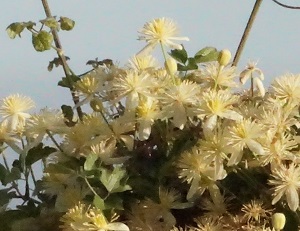 Clematis lasianta, which is also known as chaparral or pipestem clematis, is a lovely vine that is covered with gorgeous white flowers in the spring. The flowers are followed by fluffy white seed heads that make the plants look like they're covered in cottonballs. It can grow fifteen to twenty feet tall. This plant loves full sun although it prefers some shade for its roots. It does not need supplemental water after it is established. It is deciduous and may die back in cold winters, but will quickly grow back in the spring. You can see these vines in flower on many local trails in the spring.
Clematis lasianta, which is also known as chaparral or pipestem clematis, is a lovely vine that is covered with gorgeous white flowers in the spring. The flowers are followed by fluffy white seed heads that make the plants look like they're covered in cottonballs. It can grow fifteen to twenty feet tall. This plant loves full sun although it prefers some shade for its roots. It does not need supplemental water after it is established. It is deciduous and may die back in cold winters, but will quickly grow back in the spring. You can see these vines in flower on many local trails in the spring.
More at Las Pilitas and Calflora.
Vitis californica (California wild grape)
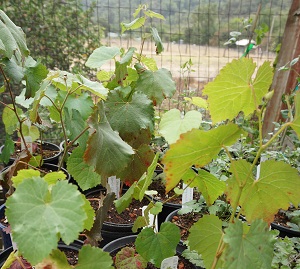
Vitis californica has beautiful, large green leaves that provide an excellent cover in the summer. In the wild, it is typically found along streams and other moist areas, but is adaptable to dry conditions after it is established. It is a deciduous vine that can grow over thirty feet tall. Since it sheds its leaves in the winter, it's great over an arbor or trellis for summer shade and winter sun. It produces bunches of small purple grapes in the fall. The grapes are edible, but tend to be tart.
Maintenance is easy. Agi Kehoe, an active member of the Gardening With Natives subgroup shares these simple pruning instructions:
Winter pruning: thin out the vine by removing all but the major canes that form the structure. Once finished, there should be one mature cane per wire line on a fence, and maybe 3 canes on a 2' wide arbor. Cut the canes back to 2-3 buds, each cut should be 1/4" above the leaf node. This is also the time to secure the large canes to the trellis with ties.
Active growing season pruning: maintain the fast growth. If trained on a fence, prune to keep it close to the fence; if trained on an arbor, leave some fresh green canes hanging down from the arbor to create a softer look.
More at Las Pilitas Nursery and Calflora.
Native Hill - Update January 2018
Author: Frank Niccoli
Native Hill at Foothill College is enjoying a renaissance. Three years ago, Frank Niccoli, an adjunct instructor at Foothill, envisioned a demonstration garden that would show the community the beauty and wisdom of using California Natives in the garden.
The first step was to install an irrigation system. This installation was made possible by a generous donation by Michelle Chu, the owner of The Village Gardener, Inc., who provided the equipment and a crew to dig the trenches and install the valves, piping and heads. Frank Niccoli designed the system and managed the installation. A total of 48 12” popups with low precipitation nozzles (0.45 gpm) were installed. David Sauter, the Director of the horticulture program at Foothill College, along with the valuable assistance from Mike Diefenback and a crew of student labor, finished the installation.
In the Spring of 2017 the plant installation and maintence class at Foothill pruned plants that had not been touched in years. They removed concrete, trash, an old drip system that never worked and established a rough outline of a pathway. They also installed the first of many plantings and sheet mulched. Niccoli commented, “I cannot wait for the new direction this garden will take. This will enhance the learning experience of the Hort Geeks and the Biology Department Foothill College by giving them a living laboratory.”
Native Hill - Update March 2016
Author: Tom Lee

Foothill College is making progress in improving Native Hill. Recently Foothill College completed some Measure C construction work in areas adjacent to Native Hill. For example, the parking lot pathway that divided the Native Hill into two gardens was improved. While this construction was underway, a long awaited irrigation project was put on hold. Now that the Measure C work is completed, most of the Native Hill garden has a new irrigation system installed and the irrigation system will be soon connected to an irrigation controller. In the meantime there are occasional workdays at Native Hill with students from the Horticulture and Biology Departments.
Many of the specimen plants, most of which date back to CNPS, are mature sized. Several species are blooming profusely right now. The newly routed bus passes by a row of Salvias, Aesculus, Arctostaphylos and Cercis that inspire the students with native plants. As with any garden keeping up with the ongoing maintenance tasks is a challenge, and more volunteers can make a big impact in keeping Native Hill in top shape.
The photos above and below were taken by Tom Lee on March 18, 2016, as he joined a workday at Native Hill with a large group of Biology students. The work was pulling out weeds and invasive grasses and then applying mulch.

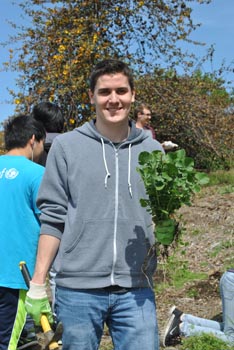
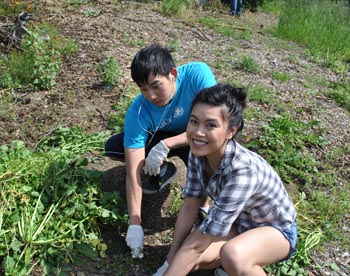
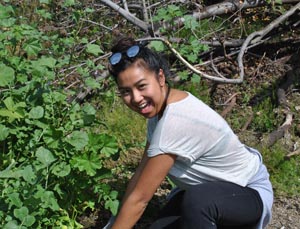
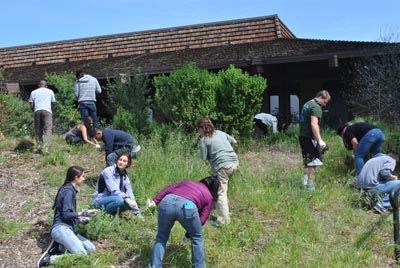

Native Hill
 Native Hill is the name for a native plant garden at Foothill College in Los Altos Hills. It was started in 1982 by Robert Will, horticulture instructor at the college and chapter president 1981- 83 and state president 1984-86. He started the collection to teach students native plant identification and care. CNPS member Ellie Gioumousis lead CNPS SCV's support for the garden for many years, helping it to reach over 160 species and cultivars.
Native Hill is the name for a native plant garden at Foothill College in Los Altos Hills. It was started in 1982 by Robert Will, horticulture instructor at the college and chapter president 1981- 83 and state president 1984-86. He started the collection to teach students native plant identification and care. CNPS member Ellie Gioumousis lead CNPS SCV's support for the garden for many years, helping it to reach over 160 species and cultivars.
Chapter volunteers have expanded and improved the collection ever since. In 1991 Don Brandeau and Mary Kaye, both design professionals and chapter members, created a unified planting design. The College added irrigation as well as removed blue gum eucalyptus, frozen in 1990, through agreement with Mal Leal, director of operations at Foothill. The native plants responded to the tree removal with improved vigor.
160 species of natives planted on this hill bring tremendous educational and aesthetic benefits. The community TV station on campus made a video featuring the garden in 1994. The SJ Mercury News had a full-page article on Native Hill in the weekend edition on July 1, 1994. Channel 6 had a half hour show on it in 1999.
The plants at Native Hill are used by faculty and students from Horticulture and Biology departments. A faculty member coordinates the activities at Native Hill.
 Clematis lasianta, which is also known as chaparral or pipestem clematis, is a lovely vine that is covered with gorgeous white flowers in the spring. The flowers are followed by fluffy white seed heads that make the plants look like they're covered in cottonballs. It can grow fifteen to twenty feet tall. This plant loves full sun although it prefers some shade for its roots. It does not need supplemental water after it is established. It is deciduous and may die back in cold winters, but will quickly grow back in the spring. You can see these vines in flower on many local trails in the spring.
Clematis lasianta, which is also known as chaparral or pipestem clematis, is a lovely vine that is covered with gorgeous white flowers in the spring. The flowers are followed by fluffy white seed heads that make the plants look like they're covered in cottonballs. It can grow fifteen to twenty feet tall. This plant loves full sun although it prefers some shade for its roots. It does not need supplemental water after it is established. It is deciduous and may die back in cold winters, but will quickly grow back in the spring. You can see these vines in flower on many local trails in the spring.
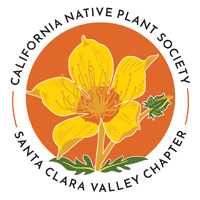








 Native Hill is the name for a native plant garden at Foothill College in Los Altos Hills. It was started in 1982 by Robert Will, horticulture instructor at the college and chapter president 1981- 83 and state president 1984-86. He started the collection to teach students native plant identification and care. CNPS member Ellie Gioumousis lead CNPS SCV's support for the garden for many years, helping it to reach over 160 species and cultivars.
Native Hill is the name for a native plant garden at Foothill College in Los Altos Hills. It was started in 1982 by Robert Will, horticulture instructor at the college and chapter president 1981- 83 and state president 1984-86. He started the collection to teach students native plant identification and care. CNPS member Ellie Gioumousis lead CNPS SCV's support for the garden for many years, helping it to reach over 160 species and cultivars.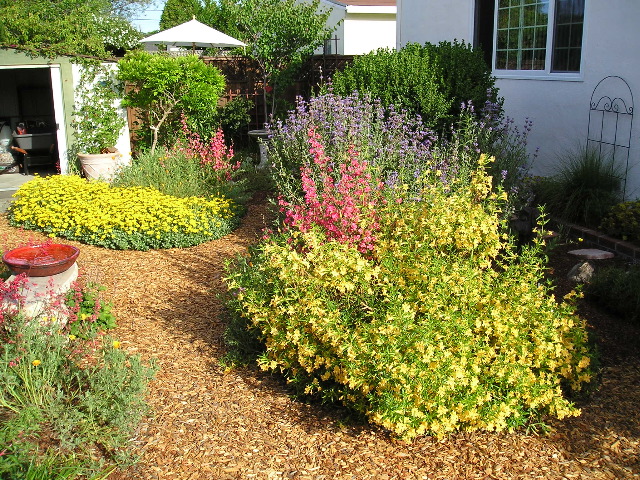 Do you want a garden teeming with life? One that changes with the seasons? One that looks stunning? One that saves water, energy, effort, and money? Consider incorporating California native plants in your garden to attract butterflies, birds, and other wildlife. These beautiful plants will bring seasonal color to your landscape. They will give your California garden a unique sense of place.
Do you want a garden teeming with life? One that changes with the seasons? One that looks stunning? One that saves water, energy, effort, and money? Consider incorporating California native plants in your garden to attract butterflies, birds, and other wildlife. These beautiful plants will bring seasonal color to your landscape. They will give your California garden a unique sense of place.